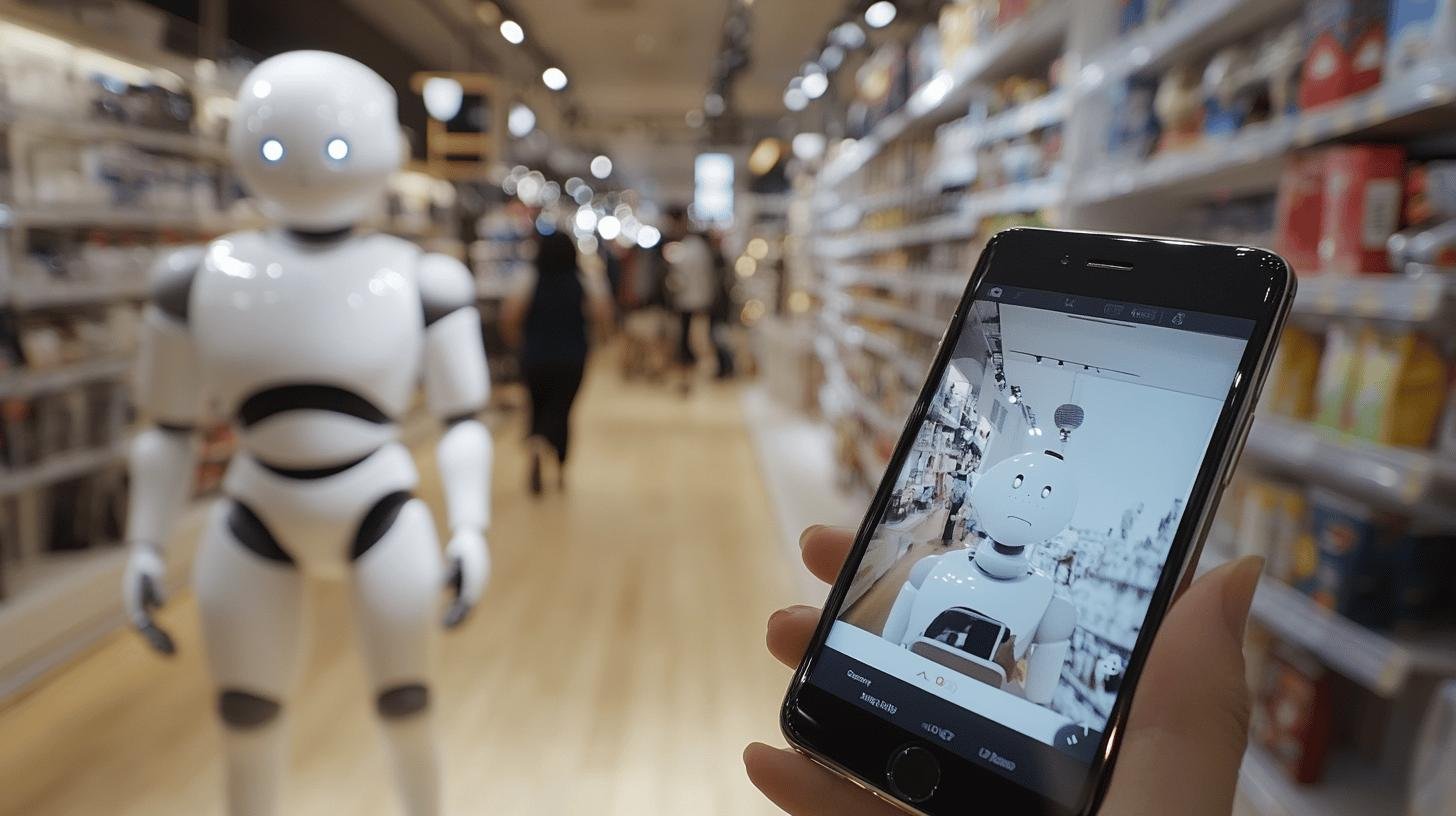Did you know that nearly two-thirds of consumers value 24/7 customer service? Yes, we are talking about chatbots for retail and turning customer service on its head! Imagine shopping at midnight and needing help; no worries, a chatbot’s got you covered. Chatbots can answer your questions, recommend products, and even track your orders. That’s just scratching the surface! Let’s explore how these digital assistants are reshaping retail and boosting customer satisfaction like never before. Ready to see the future of customer service? Let’s dive in!
How Chatbots for Retail Enhance Customer Service
Chatbots in retail are like a helpful friend, always ready to assist. They provide 24/7 customer support, so no more waiting for business hours to get answers. They can answer frequently asked questions, offer product recommendations, and handle order tracking. Imagine asking, “Where’s my order?” and getting an instant reply, even at midnight!
You know what’s cool? 64% of internet users think 24-hour service is the best thing about chatbots. For example, Decathlon, a big sports retailer, found that 29% of their bot conversations happen outside regular store hours. This means chatbots help customers exactly when they need it most.
Having 24/7 support is next level. Customers can get help whenever they need it, boosting satisfaction. Plus, chatbots take care of repetitive tasks, freeing up human agents to tackle more complex problems. This not only improves efficiency but also makes for happier employees and customers.
Boosting Sales with Retail Chatbots

Chatbots in retail are like having a personal shopping assistant right at your fingertips. They can boost sales by an average of 67%. How? By providing personalized product recommendations that cater to your tastes. It’s like having a friend who knows exactly what you like and suggests items you’ll love. Plus, chatbots are excellent at upselling. They can suggest complementary products or upgrades, making it super easy to find everything you need in one go.
Another cool thing is that 47% of consumers are open to using a chatbot to make a purchase. This means chatbots can streamline the ordering process, making shopping quick and painless. They can also send personalized notifications about discounts or special offers, keeping you in the loop about the best deals.
Chatbots also play a crucial role in reducing cart abandonment rates. Ever added items to your cart and then just left them there? Chatbots can assist during the checkout process, answering any last-minute questions and ensuring everything goes smoothly. This not only helps you complete your purchase but also improves the overall checkout experience. Customers are happier, and sales go up—a win-win situation!
Real-World Examples of Retail Chatbots
Seeing real-world examples helps us understand how chatbots can make a big difference in retail. Let’s dive into some cool case studies that show how retailers are using chatbots to transform customer service.
American Eagle’s Facebook Messenger chatbot made waves during the 2016 holiday season. This chatbot facilitated millions of messages, helping customers find products, answer questions, and even make purchases. It was like having a personal shopping assistant available around the clock, making the shopping experience more seamless and enjoyable.
Walmart’s Ask Sam voice assistant is another great example. This chatbot helps in-store associates with tasks like locating products, checking prices, and managing inventory. It’s like having a super-smart coworker who knows where everything is and can help you out in a pinch. This not only improves efficiency but also enhances the overall customer experience in the store.
Sephora’s chatbot is a game-changer in the beauty industry. This chatbot provides personalized beauty advice, helping customers find the right products for their skin type and preferences. It also assists with product reservations, making it easier for customers to get what they need. It’s like having a beauty expert at your fingertips, ready to give you the best recommendations and tips.
Benefits of Implementing Chatbots in Retail

Chatbots for retail can boost sales by 67% and save up to 70% of a team’s time. By handling repetitive tasks and automating routine inquiries, chatbots free up human employees to focus on more complex issues. This not only improves efficiency but also helps the business maximize its resources. Imagine having a virtual assistant who never takes a break—always ready to help customers and streamline sales processes.
Customer satisfaction gets a huge boost with chatbots. They provide quick, accurate responses, making it easier for customers to find what they need. Plus, chatbots collect valuable data and insights from customer interactions. This data can be used to improve products and services, making customers even happier. It’s like having a feedback loop that constantly helps you get better.
Operating 24/7, chatbots offer round-the-clock service. Customers can get help anytime, day or night, without waiting for business hours. This constant availability can significantly enhance the customer experience, meeting their needs whenever they arise. For businesses, this means fewer missed opportunities and more satisfied customers, leading to increased loyalty and sales.
Steps to Implement Chatbots for Retail in your Business
Chatbots for retail are not just a plug-and-play situation; implementing them into your business can upscale your business. It’s important to follow a structured process to make sure your chatbot does exactly what you need it to do. Let’s break it down step-by-step.
First, define your objectives and choose the right chatbot platform. What do you want your chatbot to achieve? Is it customer service, sales, or maybe both? Once you’ve got that figured out, find a platform that fits your needs. There are many out there, each offering different features and capabilities.
Next, integrate the chatbot with your existing systems. This means connecting it to your inventory, CRM, and other tools you already use. It ensures that the chatbot has access to real-time data, making interactions smoother and more accurate. Think of it as hooking your new smart gadget into your home network so everything works seamlessly together.
Now, train your chatbot using AI and NLP (Natural Language Processing). This step is crucial for better customer interaction. You want your chatbot to understand and respond to customer queries as naturally as possible. Training involves feeding it with data and continuously improving its responses based on customer interactions.
Finally, continuously monitor and optimize your chatbots for retail performance. This is not a set-it-and-forget-it deal. Regularly check how well your chatbot is performing, look for areas of improvement, and make necessary tweaks. This could be anything from updating its responses to adding new functionalities. Keeping an eye on performance ensures your chatbot remains effective and keeps customers happy.
Different Types Chatbots for Retail

Retail chatbots come in all shapes and sizes, each designed to tackle specific tasks and improve the customer experience. Let’s break down the different types of chatbots you might encounter in the retail world.
First up, we have basic or rule-based chatbots for retail. These bots handle simple queries using predefined rules and scripts. They’re like a digital version of an FAQ page, answering straightforward questions like store hours or return policies. While they’re not the smartest bots around, they’re perfect for handling routine tasks quickly and efficiently.
Next, we’ve got AI-driven chatbots. These bots use machine learning to provide more sophisticated responses. They can understand and process natural language, making interactions feel more human-like. Think of them as smart assistants who can help you find the perfect pair of shoes based on your style and previous purchases.
Virtual assistants are another cool type. These chatbots guide customers through the purchasing process, from browsing to checkout. They can help you find products, compare options, and even complete your order. It’s like having a personal shopper who’s always ready to assist you.
Social media chatbots are the new kids on the block. They engage customers on platforms like Facebook and Instagram, answering questions, providing recommendations, and even helping with purchases. These bots are perfect for reaching customers where they already spend a lot of their time. Imagine getting a message from your favorite brand on Instagram, suggesting a new product you might love. Social media chatbots make this possible, creating seamless and engaging shopping experiences.
Best Practices for Using Chatbots in Retail
Let’s chat about the best practices for using chatbots in retail. These practices are super important because they help you get the most out of your chatbot, ensuring it’s not just another tech gimmick but a real asset to your business.
First, understand your audience and define clear goals. Who are your customers? What do they need? Knowing this helps you set specific objectives for your chatbot. For instance, if most of your customers are looking for quick answers about store hours or return policies, your chatbot should be tailored to provide those answers efficiently.
Next, start with a simple chatbot and scale gradually. Think of it like learning to ride a bike—you start with training wheels. Launch a basic version first, handle a few functions like answering FAQs or tracking orders, and then add more features as you go. This way, you can test the waters and make necessary adjustments without overwhelming your system or your customers.
Using Natural Language Processing (NLP) is another best practice. NLP allows your chatbot to understand and respond to customer queries in a more natural and human-like manner. Instead of giving robotic, canned responses, your bot can engage in more meaningful conversations. It’s like upgrading from a flip phone to a smartphone—everything just works better.
Having personalized recommendations based on customer data is a game-changer. When your chatbot can suggest products based on a customer’s past purchases or browsing history, it feels like the bot really gets them. This not only boosts sales but also enhances customer satisfaction. Imagine walking into a store and having a sales associate who knows your preferences—pretty awesome, right? That’s what a well-implemented chatbot can do for your online store.
Conclusion
Chatbots in retail is next level for any business, offering around-the-clock customer support and handling FAQs, product recommendations, and order tracking. They shine by reducing the workload on human agents, especially outside regular store hours.
Not only do chatbots increase sales, but they’ve also proven effective in real-world cases like American Eagle and Sephora, offering valuable data and insights.
With benefits ranging from boosting sales to 24/7 support, chatbots for retail are a must-have. If you’re in retail, now’s the time to embrace these digital helpers for a smoother, more efficient customer experience.
FAQ
How are chatbots used in retail?
Chatbots provide 24/7 customer support, answer FAQs, assist with product recommendations, and handle order tracking. They can manage complaints and support live agents by dealing with routine inquiries.
What are the 4 types of chatbots?
The four types are basic/rule-based chatbots, AI-driven chatbots, virtual assistants, and social media chatbots. Each type offers different levels of interaction and support for customers.
What is bot in retail?
A bot in retail automates customer service tasks, answers questions, recommends products, and tracks orders. They improve efficiency and customer experience by providing instant responses.
Does Walmart use chatbots?
Yes, Walmart uses chatbots like Ask Sam, which helps in-store associates with various tasks, enhancing their efficiency and customer service quality.




